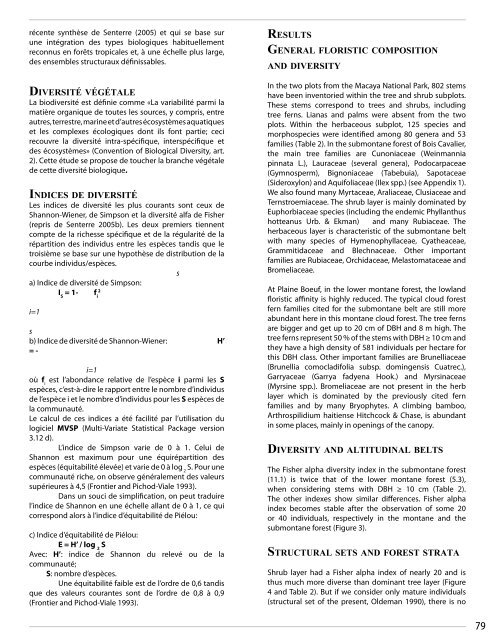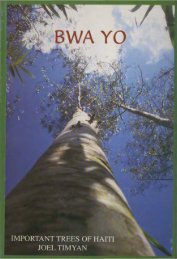Biodiversité - Société Audubon Haiti
Biodiversité - Société Audubon Haiti
Biodiversité - Société Audubon Haiti
Create successful ePaper yourself
Turn your PDF publications into a flip-book with our unique Google optimized e-Paper software.
écente synthèse de Senterre (2005) et qui se base sur<br />
une intégration des types biologiques habituellement<br />
reconnus en forêts tropicales et, à une échelle plus large,<br />
des ensembles structuraux définissables.<br />
dIversIté végétale<br />
La biodiversité est définie comme «La variabilité parmi la<br />
matière organique de toutes les sources, y compris, entre<br />
autres, terrestre, marine et d’autres écosystèmes aquatiques<br />
et les complexes écologiques dont ils font partie; ceci<br />
recouvre la diversité intra-spécifique, interspécifique et<br />
des écosystèmes» (Convention of Biological Diversity, art.<br />
2). Cette étude se propose de toucher la branche végétale<br />
de cette diversité biologique.<br />
IndIces de dIversIté<br />
Les indices de diversité les plus courants sont ceux de<br />
Shannon-Wiener, de Simpson et la diversité alfa de Fisher<br />
(repris de Senterre 2005b). Les deux premiers tiennent<br />
compte de la richesse spécifique et de la régularité de la<br />
répartition des individus entre les espèces tandis que le<br />
troisième se base sur une hypothèse de distribution de la<br />
courbe individus/espèces.<br />
s<br />
a) Indice de diversité de Simpson:<br />
2<br />
I = 1- f S i<br />
i=1<br />
s<br />
b) Indice de diversité de Shannon-Wiener: H’<br />
= -<br />
i=1<br />
où f i est l’abondance relative de l’espèce i parmi les S<br />
espèces, c’est-à-dire le rapport entre le nombre d’individus<br />
de l’espèce i et le nombre d’individus pour les S espèces de<br />
la communauté.<br />
Le calcul de ces indices a été facilité par l’utilisation du<br />
logiciel MVSP (Multi-Variate Statistical Package version<br />
3.12 d).<br />
L’indice de Simpson varie de 0 à 1. Celui de<br />
Shannon est maximum pour une équirépartition des<br />
espèces (équitabilité élevée) et varie de 0 à log 2 S. Pour une<br />
communauté riche, on observe généralement des valeurs<br />
supérieures à 4,5 (Frontier and Pichod-Viale 1993).<br />
Dans un souci de simplification, on peut traduire<br />
l’indice de Shannon en une échelle allant de 0 à 1, ce qui<br />
correspond alors à l’indice d’équitabilité de Piélou:<br />
c) Indice d’équitabilité de Piélou:<br />
E = H’ / log 2 S<br />
Avec: H’: indice de Shannon du relevé ou de la<br />
communauté;<br />
S: nombre d’espèces.<br />
Une équitabilité faible est de l’ordre de 0,6 tandis<br />
que des valeurs courantes sont de l’ordre de 0,8 à 0,9<br />
(Frontier and Pichod-Viale 1993).<br />
results<br />
general florIstIc coMPosItIon<br />
and dIversIty<br />
In the two plots from the Macaya National Park, 802 stems<br />
have been inventoried within the tree and shrub subplots.<br />
These stems correspond to trees and shrubs, including<br />
tree ferns. Lianas and palms were absent from the two<br />
plots. Within the herbaceous subplot, 125 species and<br />
morphospecies were identified among 80 genera and 53<br />
families (Table 2). In the submontane forest of Bois Cavalier,<br />
the main tree families are Cunoniaceae (Weinmannia<br />
pinnata L.), Lauraceae (several genera), Podocarpaceae<br />
(Gymnosperm), Bignoniaceae (Tabebuia), Sapotaceae<br />
(Sideroxylon) and Aquifoliaceae (Ilex spp.) (see Appendix 1).<br />
We also found many Myrtaceae, Araliaceae, Clusiaceae and<br />
Ternstroemiaceae. The shrub layer is mainly dominated by<br />
Euphorbiaceae species (including the endemic Phyllanthus<br />
hotteanus Urb. & Ekman) and many Rubiaceae. The<br />
herbaceous layer is characteristic of the submontane belt<br />
with many species of Hymenophyllaceae, Cyatheaceae,<br />
Grammitidaceae and Blechnaceae. Other important<br />
families are Rubiaceae, Orchidaceae, Melastomataceae and<br />
Bromeliaceae.<br />
At Plaine Boeuf, in the lower montane forest, the lowland<br />
floristic affinity is highly reduced. The typical cloud forest<br />
fern families cited for the submontane belt are still more<br />
abundant here in this montane cloud forest. The tree ferns<br />
are bigger and get up to 20 cm of DBH and 8 m high. The<br />
tree ferns represent 50 % of the stems with DBH ≥ 10 cm and<br />
they have a high density of 581 individuals per hectare for<br />
this DBH class. Other important families are Brunelliaceae<br />
(Brunellia comocladifolia subsp. domingensis Cuatrec.),<br />
Garryaceae (Garrya fadyena Hook.) and Myrsinaceae<br />
(Myrsine spp.). Bromeliaceae are not present in the herb<br />
layer which is dominated by the previously cited fern<br />
families and by many Bryophytes. A climbing bamboo,<br />
Arthrospilidium haitiense Hitchcock & Chase, is abundant<br />
in some places, mainly in openings of the canopy.<br />
dIversIty and altItudInal belts<br />
The Fisher alpha diversity index in the submontane forest<br />
(11.1) is twice that of the lower montane forest (5.3),<br />
when considering stems with DBH ≥ 10 cm (Table 2).<br />
The other indexes show similar differences. Fisher alpha<br />
index becomes stable after the observation of some 20<br />
or 40 individuals, respectively in the montane and the<br />
submontane forest (Figure 3).<br />
structural sets and forest strata<br />
Shrub layer had a Fisher alpha index of nearly 20 and is<br />
thus much more diverse than dominant tree layer (Figure<br />
4 and Table 2). But if we consider only mature individuals<br />
(structural set of the present, Oldeman 1990), there is no<br />
79



